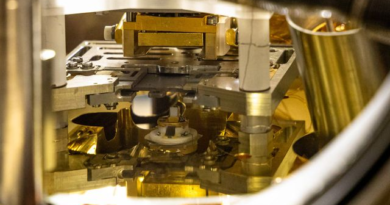US cannot halt Chinese advances, chip expert says – 台北時報
The US might not be able to stop Chinese firms, including Semiconductor Manufacturing International Corp (SMIC, 中芯) and Huawei Technologies Co (華為), from making progress in chip technology, one of the semiconductor industry’s leading figures said this week.
SMIC and Huawei, which stunned Washington by unveiling a made-in-China phone processor, can use existing older machines to make even more sophisticated silicon, former Taiwan Semiconductor Manufacturing Co (TSMC, 台積電) vice president Lin Burn-jeng (林本堅) said.
SMIC should be able to advance to 5-nanometer technology with ASML Holding NV machines that it already operates, said Lin, who at TSMC championed the lithography technology that transformed chipmaking.
Photo: AP
Huawei electrified the chip industry when it unveiled a 7-nanometer processor made by SMIC in the Mate 60 Pro, triggering celebrations in China and accusations in the US that a campaign to contain the country’s tech ascent had failed.
Yangtze Memory Technologies Co (長江存儲) is also producing some of the most advanced memory chips in the industry.
The administration of US President Joe Biden this month tightened curbs to close loopholes through which China might be accessing advanced US equipment, marking a new phase in a struggle to influence technologies crucial to the economic and political balance.
Yet that might not stop China’s technological ascent, said Lin, who is highly regarded in the industry for being the first person to propose immersion lithography, the technology that ASML’s core products rely on.
SMIC used ASML’s immersion lithography machines to make the 7-nanometer chip for Huawei, Lin said.
Beyond trying to reach the 5-nanometer milestone, it is likely that China would experiment with new materials or advanced chip packaging to make more powerful semiconductors, he said.
“It is just not possible for the US to completely prevent China from improving its chip technology,” Lin said in an interview at National Tsing Hua University in Hsinchu City, where he serves as dean of the semiconductor research college.
That echoed comments from Arm Holdings PLC chief executive officer Rene Haas earlier this month.
“What the US really should do is to focus on maintaining its chip design leadership instead of trying to limit China’s progress, which is futile, as China is adopting a whole-nation strategy to boost its chip industry, and hurting the global economy,” Lin said.
The US might have inadvertently granted Shanghai-based SMIC a golden opportunity, he added.
In 2020, Washington effectively banned TSMC — supplier of the world’s most advanced silicon to Apple Inc and Nvidia Corp — from doing business with Huawei.
That is when SMIC stepped up to inherit the massive orders that helped it to improve its manufacturing technique, Lin said.
A debate is now raging in the US and beyond about whether Washington and its allies should step up their Chinese containment campaign.
US Secretary of Commerce Gina Raimondo has said Washington does not have evidence that China can make advanced chips “at scale.”
US Under-Secretary of Commerce for Industry and Security Alan Estevez said it is “absolutely” a concern for Washington that China could use 7-nanometer technology — or better — in military applications.
Packed into a small room, a drone, bipedal robot, supermarket checkout and other devices showcase a vision of China’s software future — one where an operating system developed by national champion Huawei (華為) has replaced Windows and Android. The collection is at the Harmony Ecosystem Innovation Center in the southern city of Shenzhen, a local government-owned entity that encourages authorities, companies and hardware makers to develop software using OpenHarmony (鴻蒙), an open-source version of the operating system Huawei launched five years ago after US sanctions cut off support for Google’s Android. While Huawei’s recent strong-selling smartphone launches have been closely watched for
The waves of the Aegean Sea lap gently at the tables and chairs of two beach restaurants on Greece’s Halkidiki peninsula. It is an idyllic scene, but one that is totally illegal. Like many others in Greece, the two establishments on Pefkochori Beach do not have a license to set up shop so close to the water. After a wave of protests last summer by locals about bars and restaurants illegally covering beaches with sunbeds and tables, the Greek state is taking action. It is cracking down on rogue tourist practices with surveillance drones, satellite imagery and a special app
South Korea’s SK Hynix Inc, the world’s No. 2 memorychip maker, is to invest 103 trillion won (US$74.6 billion) through 2028 to strengthen its chips business, focusing on artificial intelligence (AI), its parent SK Group said yesterday. SK Group also said it plans to secure 80 trillion won by 2026 to invest in AI and semiconductors as well as fund shareholder returns, while streamlining its more than 175 subsidiaries. The sprawling conglomerate outlined the plans following a two-day strategy meeting, aiming to revive the group after SK Hynix, its main money maker, and the group’s electric vehicle battery arm suffered heavy losses. SK
Luxgen Motor Co (納智捷汽車), a subsidiary of Yulon Motor Co (裕隆汽車), yesterday said it is again offering a NT$100,000 discount for its entry-level n7 electric vehicle models. The n7’s price has gone down from NT$1.099 million to NT$999,000, Luxgen said, adding that there are 25,000 preorders for the model. MG Motor’s electric hatchback, the MG4, entered the market in the middle of last month, with a starting price of NT$990,000. China Motor Corp (中華汽車), which distributes MG vehicles in Taiwan, said it aims to sell 1,600 MG4s this year. MG, originally a British brand, was acquired by China’s SAIC Motor

